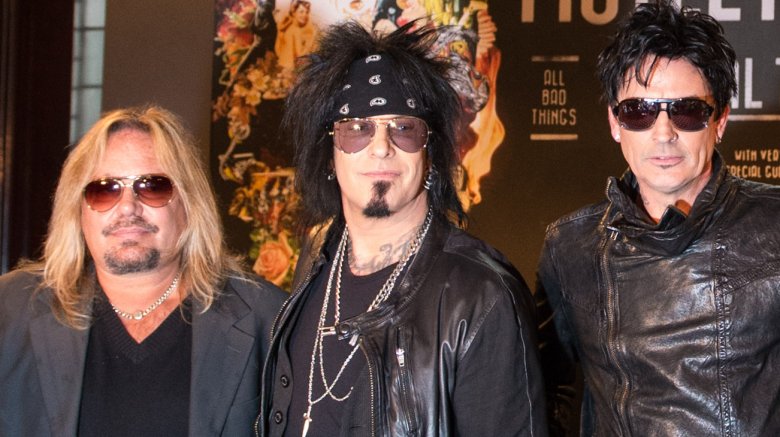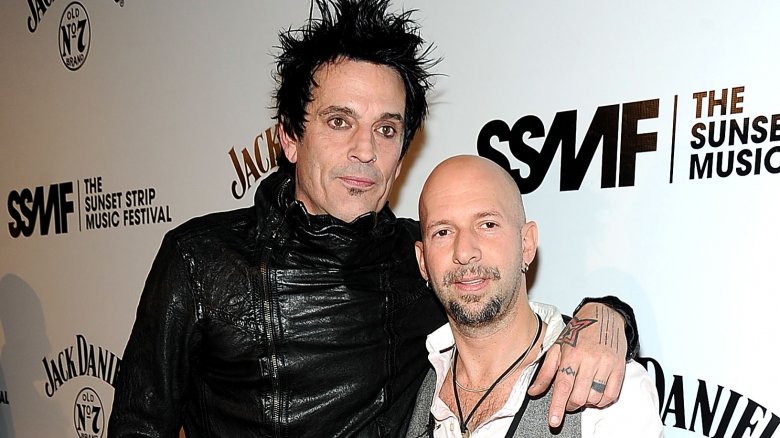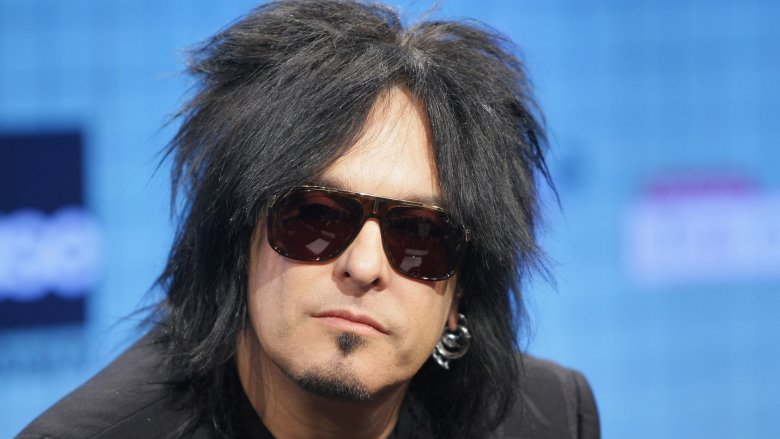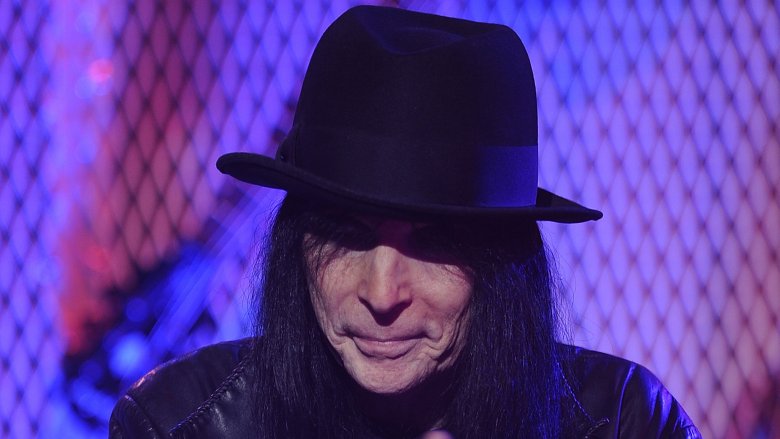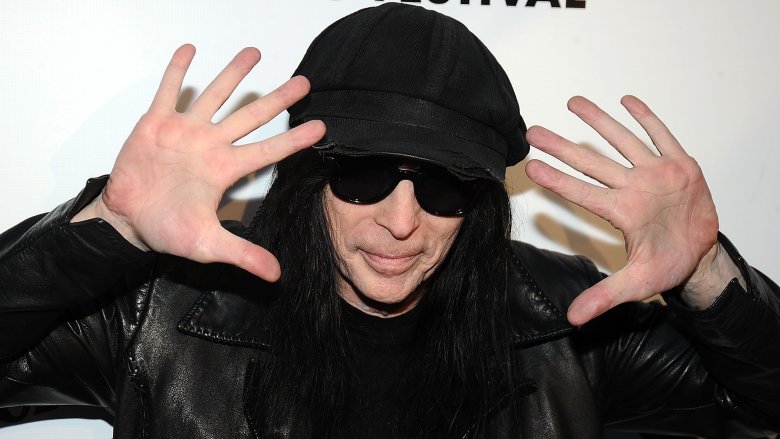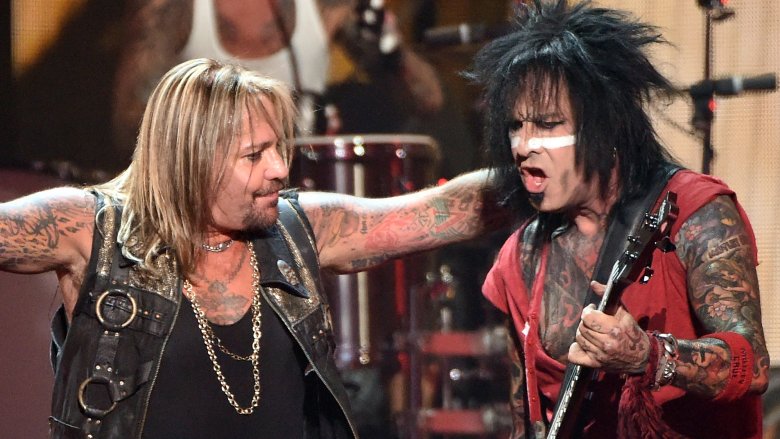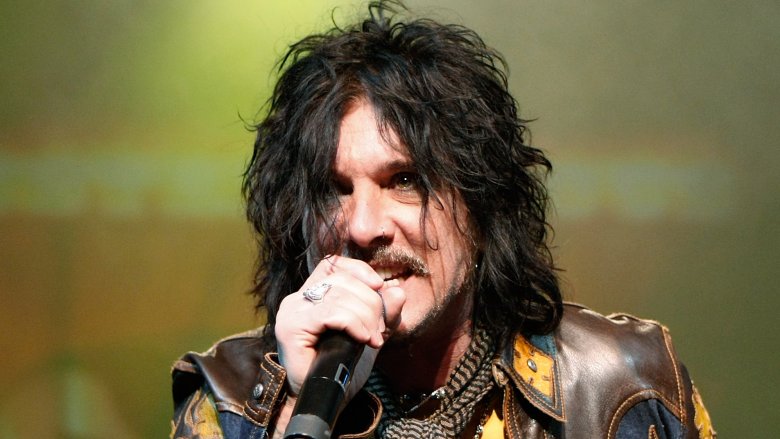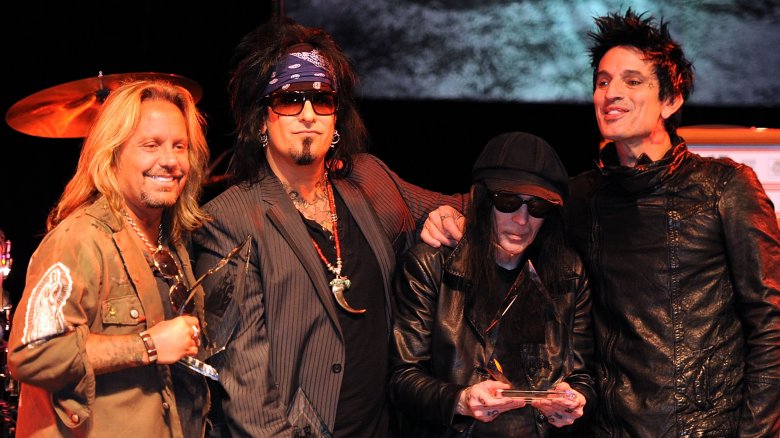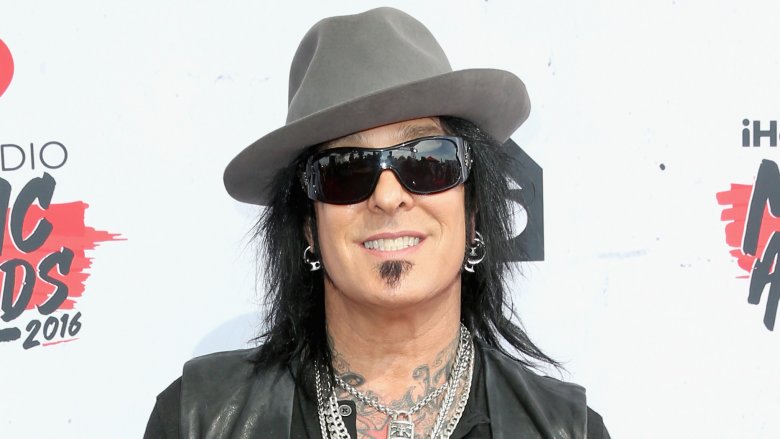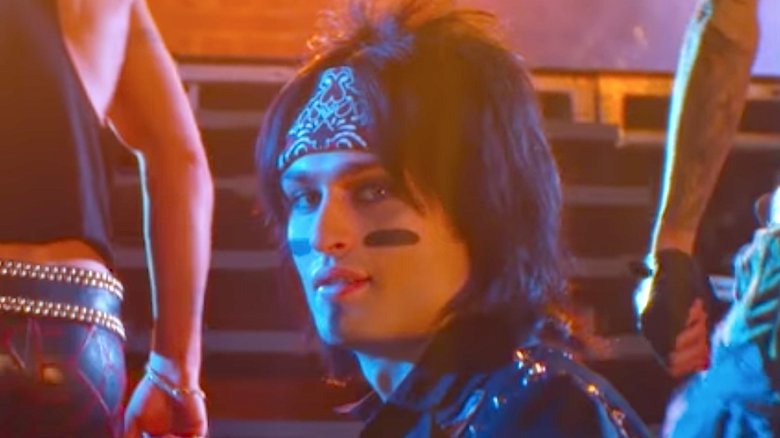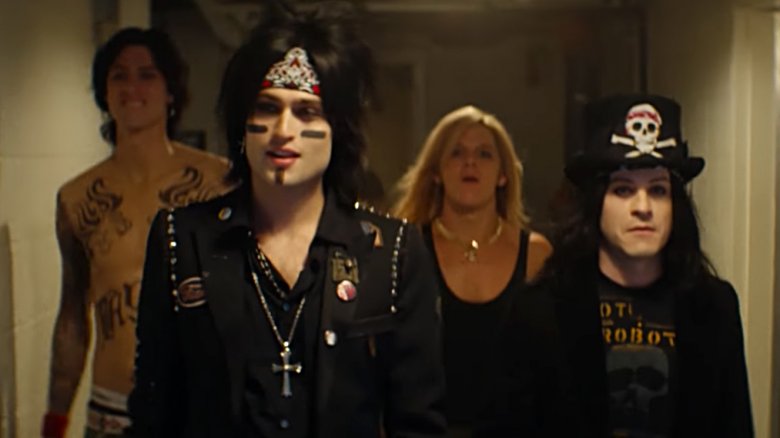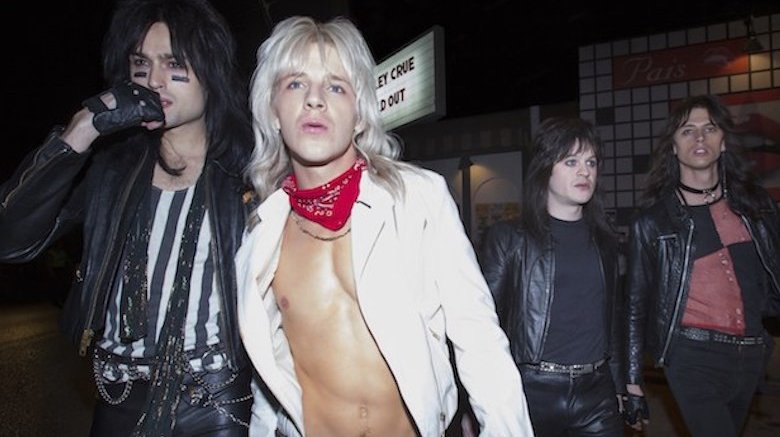The Untold Truth Of The Dirt
Perhaps the definitive band of the sleazy, L.A.-based "hair metal" era, Mötley Crüe sold millions of copies of party-hard records like Too Fast for Love, Shout at the Devil, and Girls, Girls, Girls and songs including "Looks That Kill," "Dr. Feelgood," and "Kickstart My Heart." In-fighting, the pressures of success, and extreme personal problems ultimately drove the most popular lineup of this oh-so-'80s band apart in the early '90s. But the music brought them back together, and in 2001, bassist and main songwriter Nikki Sixx, singer Vince Neil, guitarist Mick Mars, and drummer Tommy Lee collaborated on arguably their most legendary project — The Dirt: Confessions of the World's Most Notorious Rock Band. Legendary miscreants, the band seemingly indulged every hedonistic impulse they ever had, and they compiled all those stories (with the help of writer Neil Strauss) into a book that set a new standard for the delightfully profane literary subgenera of rock biographies.
Here's a look behind the making of the book, some of the most curious stories from the book, and the long road it took to bring it to the screen. In other words, this is the dirt on The Dirt.
The other Neil in Mötley Crüe
Compared to other rock biography books, The Dirt just has a lot... more. It's got more stories of illegal activity and heavy metal debauchery, and it's also got a lot of authors. Five guys are credited on the cover: Mötley Crüe band members (in alphabetical order) Tommy Lee, Mick Mars, Vince Neil, and Nikki Sixx, along with Neil Strauss. He's the guy who did all the interviewing and assembled a coherent narrative out of what must have been stacks of tapes and copious notes culled from following around four guys for months. The Dirt is Strauss's filthy baby, and this kind of book is his specialty — he's also coauthored salacious memoirs by Dave Navarro and Marilyn Manson.
Strauss first hooked up with Mötley Crüe in 1998, when he briefly toured with the band for a profile in Spin. At the time, he was finalizing his Manson book, The Long Hard Road Out of Hell, and the Crüe members that read it loved it. When publisher HarperCollins contracted the group for a book later on, they immediately asked Strauss to helm the project. Once more, he went on tour with Mötley Crüe and visited each musician at (home sweet) home. Probably the hardest part for him to write: Vince Neil's account of his four-year-old daughter's ultimately tragic battle with cancer. "He was crying, I was crying. It tore me apart," Strauss told MTV. "When I gave him the book, I said, 'You might not want to read this."
They really like breakfast burritos
The Dirt manages to top most every other rock biography with its sheer volume of nauseating and unbelievable tall tales. For while Hammer of the Gods breathlessly describes every despicable and disgusting act ever committed by the members of Led Zeppelin, it can't compete with Vince Neil's egg burrito story from The Dirt. The Mötley Crüe singer discusses the band's good ol' days, its early years as a band playing L.A.'s Rainbow club by night, and using drummer Tommy Lee's Chevy van as a "party truck" later at night.
"After the Rainbow each night, we'd walk to Santa Monica Boulevard, where all the young rockers and actors who never made it were pimping themselves," Neil said. And then, even if they had girlfriends at the time, they'd, well, physically entertain "anything stupid or drunk enough to get into Tommy's van." Afterwards, the Crüe would "scrounge up enough money to buy a breakfast burrito from a local establishment (which would probably prefer to remain nameless). Then, each member of the band would place their genitals "into the warm meat to cover up the smell" of the women who had been there earlier. Why? "So that our girlfriends didn't know." Oh.
There's no crying in rock n' roll
While The Dirt reveals one brazen display of Caligula-like excess after another, the book's warts-and-all treatment goes a bit beyond the drug-taking and sexual exploits one would assume a Mötley Crüe tome would detail. For instance, in the mid-1980s, the band's reps sought to protect its investment and made every member of the the drink-and-drug-addled group get clean. "Our management was trying to do some kind of extensive plastic surgery on the band, and we had to see all these doctors who would try to brainwash us into behaving differently," guitarist Mick Mars recounted. "Once a week we'd have to go to relationship counseling like an old bitter married couple. There, we'd learn how to talk to each other instead of fighting or we'd discuss our feelings and whatever was going on that week."
While Mars resented all that, especially since he'd kicked his habits without any formal help, it was when the waterworks began that really irked him. "Every therapist wanted us to let loose and cry, and I hate crybabies," Mars said. "I became so sick of seeing everyone in the band bawling their eyes out. Go back to the second grade if you want to cry, sucka**."
The worst day in Crüe history
December 8, 1984 looms dark in rock history. That's when an intoxicated Vince Neil drove himself and Hanoi Rocks drummer Razzle to a liquor store to get more booze for a multi-day party. Neil lost control on a winding road and smashed into another car, instantly killing his passenger. The Dirt tells this horrific story, but it also reveals that a few hours before that tragedy, another sad and shocking event nearly befell the group.
Neil awoke that afternoon to see something on the beach, which he described as "a small black whale." Upon examination, it was Mick Mars, "passed out in the sand" in black leather from head to toe. What did Neil do? Nothing. "He mumbled something about just wanting to be left lying there," Neil wrote, "so I left him there, looking like E.T. when he was sick."
After dark, Mars regained consciousness... although he "was sure" he was dead and was now a ghost, and instinctively headed toward a "glow of light coming from the distance." It was Neil's house, where the party had turned sad and silent. "I figured that they were crying for me: that I had drowned in the water and they had discovered my body," Mars said. He tried to walk through a window — since he was a ghost — to hear what everyone was talking about in hushed tones, only to hurt himself pretty bad and later learn about his bandmate's deadly car accident.
You can't fire Vince Neil, because he quit!
According to band manager Doug Thaler in The Dirt, Vince Neil's self-sabotaging behavior in the early '90s threatened his position in Mötley Crüe. Ultimatums, a rehab stint, and promises all resulted, but by the end of 1991, Neil was leaving in-studio rehearsals early, "claiming he was too tired to sing." By February 1992, bassist Nikki Sixx was over it.
During a major rainstorm that flooded large parts of L.A., each member made the treacherous journey to the studio. But not Neil, who, according to Sixx, "lived half the distance away that we did." After waiting for Neil for hours, the band's tour manager faxed the singer, telling him to show up ASAP. Neil then called, explaining that he hadn't done so already because the phone lines were down. Then how did you get the fax? Sixx wondered. "That set me off," he wrote. Then a studio tech pointed out that Neil had been seen partying at 3AM the previous night, and, according to Sixx, "By the time he arrived the seed was already planted in our minds that he was holding us back."
Neill finally arrived, "soaked and sulking." Sixx casually mentioned that the band was considering "new lead singer talks," while Neil retorted that the reason he skipped rehearsals was because "The album is stupid." After more bickering, Neil left in a huff, bellowing, "I'm f****** out of here! I quit!"
"He says he was fired," Sixx wrote. "I say he quit."
New decade, new guy, same Crüe
After the huge sales of the 1989 album Dr. Feelgood, Elektra Records was eager to stay in the Mötley Crüe business, and in 1991 gave the band to a $25 million contract... but the band's future remained shaky. "We tried to discourage the band from getting rid of Vince," manager Doug Thaler wrote. "If Elektra chose to, it could exercise one of its options and renege on the deal if Vince left." Nothing doing; Neil's ouster stood.
In his stead, the group recruited singer John Corabi. The record the new Crüe recorded ate up, according to Thaler, "14 months and $2 million" in studio costs. All that for a relative dud. Released in March 1994, Mötley Crüe debuted at #7 on the Billboard 200. And then, "a friend who gets the chart numbers early called" Thaler to let him know that in week two, the album fell "all the way to 28." The supporting tour was an ominous disaster. Nikki Sixx recalled that at the first stop in Tucson, Arizona, "only 4,000 tickets had been sold for a 15,000 seat amphitheater," and he tried to give away tickets at a radio station... and only two people showed up. "And that's when I realized: It was all over," Sixx said. The massive arena tour soon became a series of small club dates.
What happened? Rock drastically changed between Dr. Feelgood and 1994. The L.A. hair metal sound was out; grunge and alternative rock were in.
Books are so totally metal
Mötley Crüe was old news in the '90s, with the low sales of Mötley Crüe surpassed by even lower sales of its 1997 follow-up, the Neil reunion record Generation Swine. There was nowhere to go but up, and rather than chase trends, Mötley Crüe embraced what fans wanted them to be — inveterate, degenerate party monsters. And they did it not with an album, or tour, or even a reality show — they did it with The Dirt. "That book became a tent post," Crüe manager Allen Kovac told FastCompany. "We marketed it like a record and we dropped a greatest hits album with it."
Not only did literate music fans come to expect a certain amount of sordid detail in rock memoirs in the wake of The Dirt, but it spawned a cottage industry in Mötley Crüe books. The success of The Dirt inspired Tommy Lee and Vince Neil to go solo with their own individual memoirs, Tommyland and Tattoos & Tequila, respectively, while Nikki Sixx cleaned up the journals he wrote during the depths of his drug addiction to create The Heroin Diaries.
Based on a familiar story
Musicians take inspiration from wherever they can, and it's an old artistic maxim to "write what you know." Nikki Sixx, always Mötley Crüe's most dominant and prolific songwriter, took both of those ideas to heart... even if things got a little too snake-eating-its-own-tail or Inception-y along the way.
The Dirt dredged up so many memories for Sixx and his bandmates — some bad, mostly good — that they got back together with departed drummer Tommy Lee to carefully craft and record a brand new album with the original lineup for the first time in more than a decade. That record: 2008's Saints of Los Angeles. And while many Mötley Crüe songs are based on actual experiences in Sixx's life ("You're All I Need" accuses a lover of cheating on him with soap star Jack Wagner; "Kickstart My Heart" is about needing medical attention after a nearly fatal overdose), Saints is "loosely based on The Dirt," he told reporters. In other words, it's the musical version of a book that's about... himself and the other members of Mötley Crüe. In fact, the LP was almost actually named The Dirt.
The movie took forever
The Dirt first thrilled not-easily-revolted readers and rocked its way to the New York Times bestseller list back in 2001... and the film version didn't make its Netflix debut until 2019. That's a long time between source material and adaptation, but it's not because nobody was trying. A film version of The Dirt could have hit movie screens in late 2006 or early 2007. That's when Paramount Classics forged an agreement to make the movie with MTV Films. Larry Charles signed up to direct, and The Dirt would've been his bold and brash follow-up to Borat. Things got as far as a table read of the script in 2014, but then Focus Features brought the project back from the dead in 2015, with Jackass veteran Jeff Tremaine already attached as a director. Even once Netflix acquired the rights to the movie version of The Dirt, it took a full two years to get the thing from signed contracts to Rokus and laptops across the world.
They're not with the band
Playing a rock star must be fun for actors. They get to live out their wildest rock star fantasies, and awards consideration is often part of the conversation. In the past two decades, a number of actors have won Oscars for portraying real-life musical icons, including Rami Malek (Freddie Mercury in Bohemian Rhapsody), Jamie Foxx (Ray Charles in Ray), and Reese Witherspoon (June Carter Cash in Walk the Line).
But when The Dirt finally got made, filmmakers went with a cast made up largely of performers who aren't quite household names, such as Games of Thrones star Iwan Rheon as Mick Mars and Douglas Booth (Jupiter Ascending) as Nikki Sixx. Over the years, a number of much bigger stars were pursued or attached to the project. In 2007, Vince Neil announced at the opening of his Las Vegas tattoo parlor (via RTE) that the legendary Christopher Walken had signed on to play the legendary Ozzy Osbourne, while Val Kilmer was a go for a cameo as David Lee Roth. (Neither of those came to pass, with the roles going to Tony Cavalero and Christian Gehring, respectively.) When Netlix landed the rights in 2017, "sources" told Variety that Liam Hemsworth was the "top choice" for Nikki Sixx. (That also didn't happen.)
Filming the movie was an electrifying experience
In both the book and film adaptations of The Dirt, cheating death is a major, recurring theme. Vince Neil walked away from a drunk driving accident that killed his passenger, Mick Mars thought he died on a beach one day, and Nikki Sixx recalled the time he was actually dead for a few minutes. It would seem that the theme of walking up to the abyss — and walking back — extended to the making of the film adaptation of The Dirt.
During production in New Orleans in March 2018, a member of the film's crew was de-rigging a set. That means he was removing all the electrical equipment necessary to run a major film shoot... when one of those implements delivered him a nasty electrical shock. "Even though all of our safety protocols were in place, an accident did occur and a crewmember was injured by electricity," a rep for the film told The Hollywood Reporter. Filming wasn't interrupted, because the cast was off shooting somewhere else while this ill-fated de-rigger was tearing down a set that was no longer needed. EMTs took him to a nearby hospital, where he was listed in stable condition and recovered.
Where rap meets rock
Not counting Saturday Night Live star Pete Davidson as record company A&R guy Tom Zutaut and David Costabile — forever Gale from Breaking Bad — as band manager Doc McGhee, the biggest "name" to appear in The Dirt is popular hip-hop star Machine Gun Kelly. He's portraying drummer Tommy Lee in the film (although he's billed, as he was in Bird Box and Nerve, under his real name, Colson Baker.)
If it seems weird for a rapper to play a rocker, it shouldn't, considering Methods of Mayhem, Tommy Lee's occasional Limp Bizkit-esque rap-rock project. Colson — sorry, Kelly — is feeling those Crüe vibes, too. He collaborated with the members of Mötley Crüe on a song that will feature on the soundtrack for The Dirt. That's just one of four new songs the otherwise retired and dispersed Crüe laid down for the movie based on their experiences.
